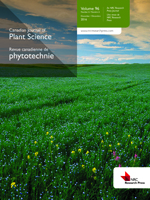Mohr, R., Nelson, A., Tomasiewicz, D., McLaren, D., Monreal, M., Irvine, B., Khakbazan, M., Moulin, A., Derksen, D. and Volkmar, K. 2015. Nutrient status and crop productivity following a 14-year irrigated potato rotation study. Can. J. Plant Sci. 95: 351-360. Well-managed crop rotations contribute to high productivity and quality in subsequent crops, and neither excessively deplete nor increase soil nutrient levels. A field experiment was conducted in the year following completion of a 14-yr irrigated potato (Solanum tuberosum L.) rotation study to assess the impact of preceding rotation on soil P, K and micronutrient concentrations, and on soybean (Glycine max) productivity, yield and seed nutrient levels. Soybean was grown on six established rotations [potato with canola (PC), wheat (PW), canola-wheat (PCW), oat-wheat (POW), wheat-canola-wheat (PWCW), and canola underseeded to alfalfa-alfalfa-alfalfa (PCAA)] arranged in a randomized complete block design (RCBD) with four replicates. Soil nutrient levels fell within ranges typical of the region, as did soybean yield and quality. Lower P and K concentrations in spring soil samples, and in soybean seeds, were typically associated with PCAA, suggesting that fertilizer additions did not account for high rates of P and K removal by alfalfa hay in this rotation. While preceding rotation had minimal effects on soil Cu and Zn, soybean established after PCAA or after potato contained comparatively higher seed Cu and Zn concentrations suggesting that including mycorrhizal crops such as potato and alfalfa in rotation may have contributed to enhanced micronutrient availability. Soybean yield was 4-6% higher following potato than canola or cereals, and 6% higher following POW than PCW. Seed protein increased and oil concentration decreased where preceding rotations included alfalfa. The limited yield differences observed may have been due, in part, to the selection of soybean as an indicator crop, which likely minimized differences among rotations arising from disease, weeds and nitrogen. These findings suggest that, with careful management of irrigated potato systems over the longer term, crop productivity and nutrient availability may be maintained within acceptable levels for agricultural production.
How to translate text using browser tools
10 February 2015
Nutrient status and crop productivity following a 14-year irrigated potato rotation study
R. Mohr,
A. Nelson,
D. Tomasiewicz,
D. McLaren,
M. Monreal,
B. Irvine,
M. Khakbazan,
A. Moulin,
D. Derksen,
K. Volkmar
ACCESS THE FULL ARTICLE
It is not available for individual sale.
This article is only available to subscribers.
It is not available for individual sale.
It is not available for individual sale.

Canadian Journal of Plant Science
Vol. 95 • No. 2
March 2015
Vol. 95 • No. 2
March 2015
assolement
micronutrients
oligoéléments
phosphore
phosphorus
pomme de terre
potassium




